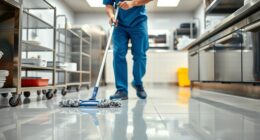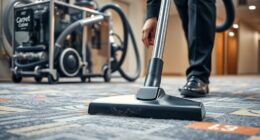For your end-of-year office cleaning, prioritize packing up holiday decorations, tidying and sanitizing workspaces, and deep cleaning office floors. Don’t forget to pay extra attention to high-traffic areas and the break room—it’s essential for hygiene. Decluttering individual workspaces and addressing shared spaces will boost morale and productivity. Finally, review and replenish cleaning supplies. With a solid cleaning plan, you set a fresh tone for the new year ahead and guarantee a healthier workspace. Learn more about effective cleaning strategies!
Key Takeaways
- Prioritize decluttering workspaces and digital files to enhance focus and productivity for the upcoming year.
- Deep clean high-traffic areas, including floors and shared spaces, to reduce germ accumulation and improve hygiene.
- Sanitize high-touch surfaces such as doorknobs and shared equipment to minimize the spread of germs.
- Organize and archive documents efficiently, implementing a user-friendly digital filing system for better accessibility.
- Conduct an inventory of cleaning supplies, ensuring adequate stock of eco-friendly products for a healthier workspace.
Pack up Holiday Decorations

As you tackle the task of packing up holiday decorations, gather your team to make the process more efficient and enjoyable.
Start by sorting decorations into keep, discard, and recycle piles. This helps declutter your desk and create an organized workspace. Use a cleaning checklist to guarantee you don’t miss any items. Adopting minimalist habits can further streamline your packing process and reduce future clutter. Embracing a minimalist lifestyle can enhance your overall productivity and well-being.
Sort your decorations into keep, discard, and recycle piles for a clutter-free workspace and an efficient packing process.
Pack the kept decorations in clearly labeled boxes to facilitate quick setup for the next holiday season. Secure ribbons, wreaths, balloons, and hanging ornaments to prevent damage during storage.
By recycling materials where possible, you promote sustainability while reducing waste. This end-of-year cleanup not only contributes to a clean office but also sets a positive tone for the upcoming year. Incorporating smart tips for cozy living can enhance your workspace even further.
Happy packing!
Tidy, Then Sanitise
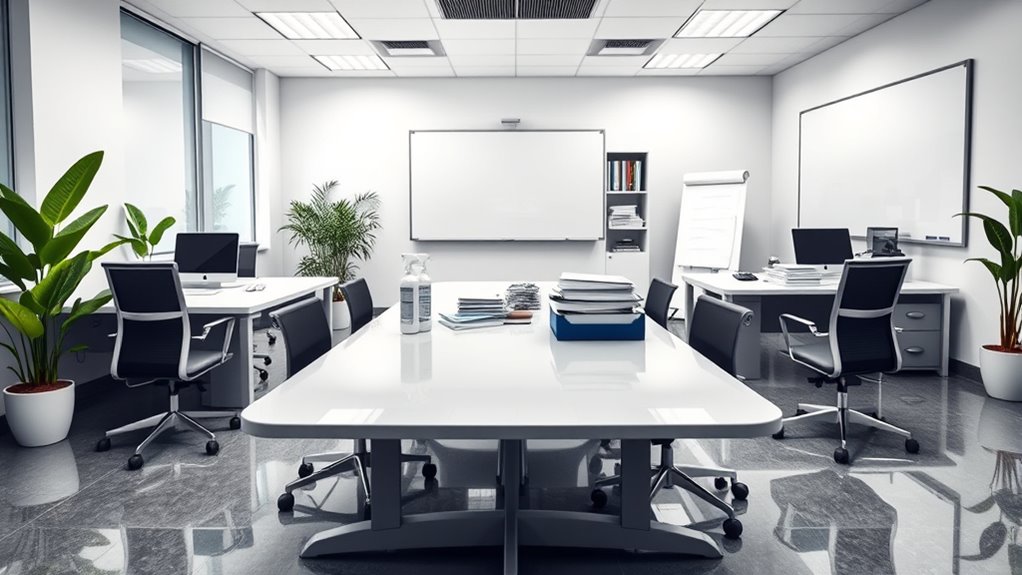
To create a healthier and more productive workspace, start by tidying up your desk before diving into sanitizing. Clear clutter by sorting through files and sticky notes, and dispose of anything unnecessary. This not only helps you stay organized but also enhances focus.
Prioritize reuse and recycling to maintain a sustainable office environment.
Once your space is tidy, move on to sanitizing. Use a disinfectant and a microfiber cloth to thoroughly clean desks, tables, and chairs, paying special attention to high-touch areas like keyboards and mice.
Incorporating a clutter-free space can significantly improve the overall ambiance of your office.
Regular tidying and sanitizing routines in shared spaces can markedly reduce harmful bacteria and viruses, promoting employee well-being and creating a more inspiring office environment.
Deep Clean Office Floors
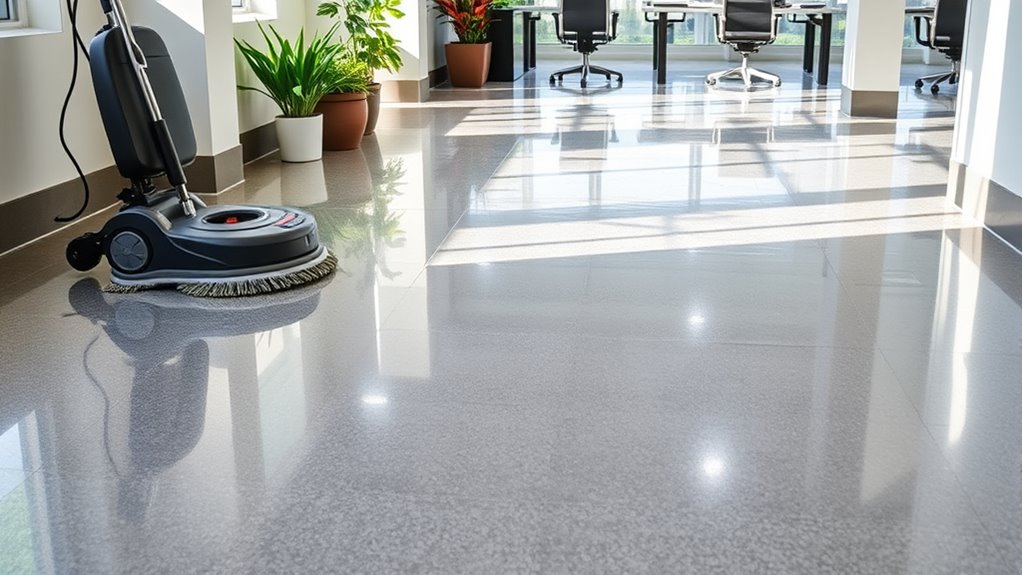
Clean floors are essential for a healthy workspace, as they can harbor harmful bacteria and allergens.
Regular vacuuming helps, but professional steam cleaning really tackles dirt and improves air quality.
For hard floors, sweeping and mopping with disinfectants not only enhances safety but also keeps your office looking its best.
Importance of Clean Floors
While maintaining a tidy office might seem like a minor detail, the importance of clean floors can’t be overstated. Clean floors greatly boost air quality by reducing dust and allergens, which directly impacts employees’ health and productivity.
Regular deep cleaning of carpets not only enhances their appearance but also extends their lifespan, creating an inviting workspace. For hard floors, frequent sweeping and mopping are essential to eliminate dirt and grime, maintaining hygiene and minimizing slip hazards.
Don’t forget about vacuuming carpets regularly to remove bacteria and allergens, which can lead to fewer sick days. Disinfecting floors, especially in high-traffic areas, is vital for minimizing the spread of germs, particularly during cold and flu season. Additionally, proper disposal habits can also contribute to a cleaner and healthier office environment.
Recommended Cleaning Techniques
Transforming your office floors is essential for creating a welcoming and healthy workspace. To achieve this, follow a solid cleaning schedule that includes deep cleaning techniques.
Here are some recommended approaches:
- Regularly vacuum carpets to eliminate dust and allergens.
- Sweep and mop hard floors with suitable cleaning supplies to remove dirt and grime.
- Schedule professional steam cleaning to sanitize carpets, removing bacteria and germs.
- Disinfect high-traffic areas with surface wipes or sprays after sweeping or mopping.
Sanitize High-Traffic Areas

When it comes to keeping your office healthy, focusing on high-traffic areas is key.
Make sure to clean high-touch surfaces regularly and set up sanitizing stations where employees can easily access them.
This simple routine can markedly reduce the spread of germs and create a safer workspace for everyone.
Essential Cleaning Stations
Creating essential cleaning stations in your office is key to maintaining a hygienic environment, especially in high-traffic areas.
By placing these stations strategically, you can effectively combat the spread of germs. Here are some cleaning tips to take into account:
- Wipes and hand sanitizers: Make them available for easy access.
- Frequent disinfection: Target frequently touched surfaces like door handles and light switches.
- Regular maintenance: Sanitize these stations throughout the day to guarantee effectiveness.
- Feedback loop: Encourage staff to report supplies that need replenishing.
Implementing these cleaning stations not only improves your work environment but also promotes a culture of hygiene, making everyone feel safer and healthier in the office.
Focus High-Touch Surfaces
To guarantee a healthy office environment, focusing on high-touch surfaces is essential, especially since these areas can harbor considerably more bacteria than others.
Office managers should prioritize regularly disinfecting surfaces like doorknobs, light switches, and elevator buttons, as studies show this can reduce germ spread by over 80%.
During peak cold and flu seasons, consider having your cleaning team sanitize these high-traffic areas multiple times a day. Additionally, providing hand sanitizing stations nearby will help maintain personal hygiene among employees, further minimizing the risk of illness.
By implementing a thorough cleaning schedule that emphasizes high-touch surfaces, you’ll foster a cleaner workspace, ultimately boosting employee productivity and health.
Don’t overlook this important aspect of office cleanliness!
Clean the Break Room

Cleaning the break room is essential for maintaining a healthy workplace, as it directly impacts employee morale and hygiene. A clean break room not only fosters a positive atmosphere but also helps prevent the spread of germs.
Here are some tasks to prioritize:
- Regularly clean countertops, tables, and appliances to maintain cleanliness.
- Empty the fridge and discard expired food items to eliminate odors.
- Wipe down microwave interiors and coffee machines for sanitary use.
- Sanitize high-touch surfaces like doorknobs and shared utensils to reduce illness risk.
Encouraging staff to keep the break room tidy by posting reminders and providing cleaning supplies can foster a culture of shared responsibility for cleanliness.
Taking these steps guarantees a pleasant environment for everyone.
Organize Digital Files
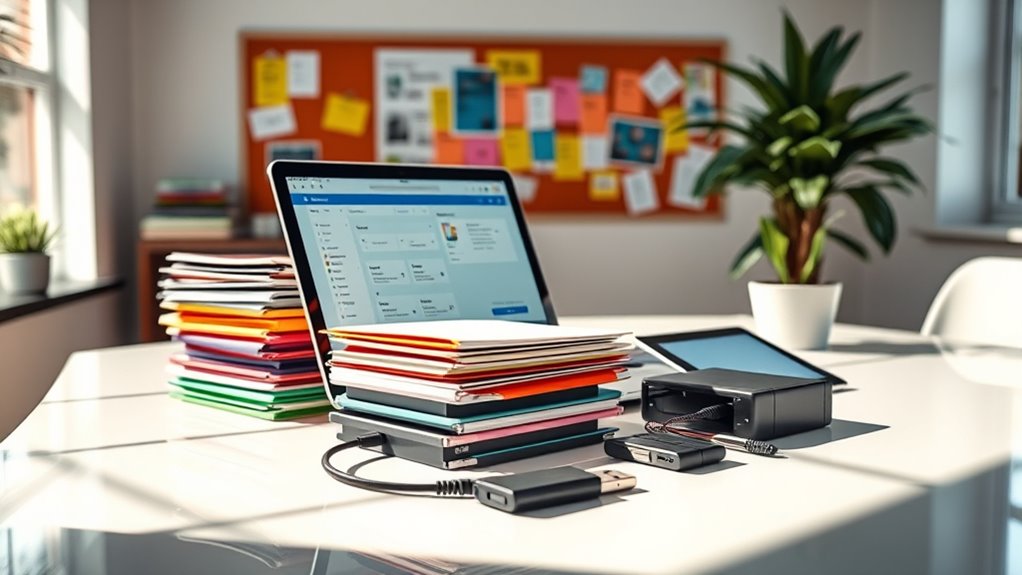
Now’s the perfect time to sort your digital files and archive those you no longer use.
By streamlining your documents, you’ll save time and make it easier to find what you need.
Plus, getting rid of unnecessary files can boost your computer’s performance and free up storage space.
Sort Files Efficiently
An organized digital workspace makes it easier to find what you need when you need it. Sorting your files efficiently is an essential part of maintaining productivity.
Here’s how you can streamline your organization:
- Categorize files into specific folders like “Active Projects,” “Archived Documents,” and “Reference Materials.”
- Use a consistent naming convention, including dates and descriptive titles, to simplify searching for important documents.
- Regularly delete or archive files that you no longer need; even a small reduction in clutter can boost your focus.
- Utilize cloud storage for easy access and sharing, enhancing collaboration with colleagues.
- Additionally, consider implementing user consent management to ensure that your digital workspace complies with privacy standards.
Incorporating these cleaning tasks into daily routines will help you maintain an organized digital workspace and prevent file clutter from accumulating over time.
Archive Unused Documents
After sorting your files efficiently, the next step is to archive unused documents. Regularly reviewing and deleting outdated files can greatly increase productivity by reducing clutter.
Studies show that employees spend about 30% of their workday searching for information, and disorganized files can lead to a 21% drop in efficiency. Implement a digital filing system by categorizing files, and consider using cloud storage solutions for easy access and collaboration among your cleaning staff.
This not only protects your important documents but also minimizes the risk of data breaches, as excess data can increase vulnerability. Make archiving a quarterly maintenance task to guarantee compliance with data retention policies and maintain effective data management practices.
Declutter Workspaces
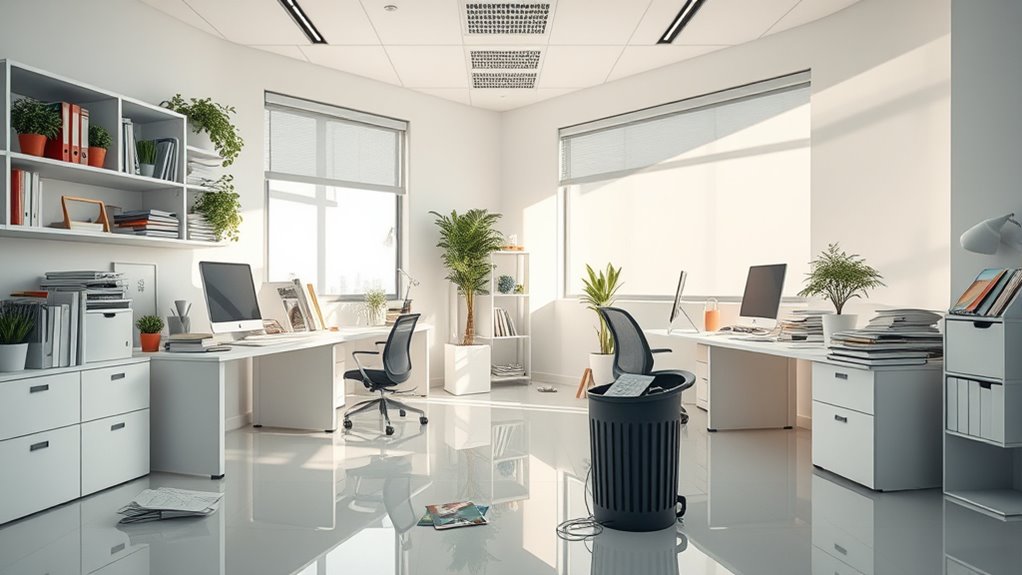
While you might feel overwhelmed by clutter, taking the time to declutter your workspace can greatly boost your productivity. Studies show that a tidy environment can enhance focus and efficiency by up to 23%.
Decluttering your workspace can significantly improve productivity, enhancing focus and efficiency by as much as 23%.
Start by regularly sorting through documents and supplies to eliminate unnecessary items. This not only reduces stress but also makes essential materials easier to find. Incorporating mindfulness practices into your decluttering routine can further enhance your self-awareness and help you make intentional decisions about what to keep.
Here are some tips to help you declutter workspaces effectively:
- Set aside 10 minutes daily for a quick cleanup.
- Use organizers like trays and file folders for better functionality.
- Encourage personalization while maintaining cleanliness.
- Prioritize clean offices to foster a sense of ownership and responsibility.
Additionally, a clean workspace reduces allergens and pollutants, which can further improve your overall well-being and productivity.
Address Shared Spaces
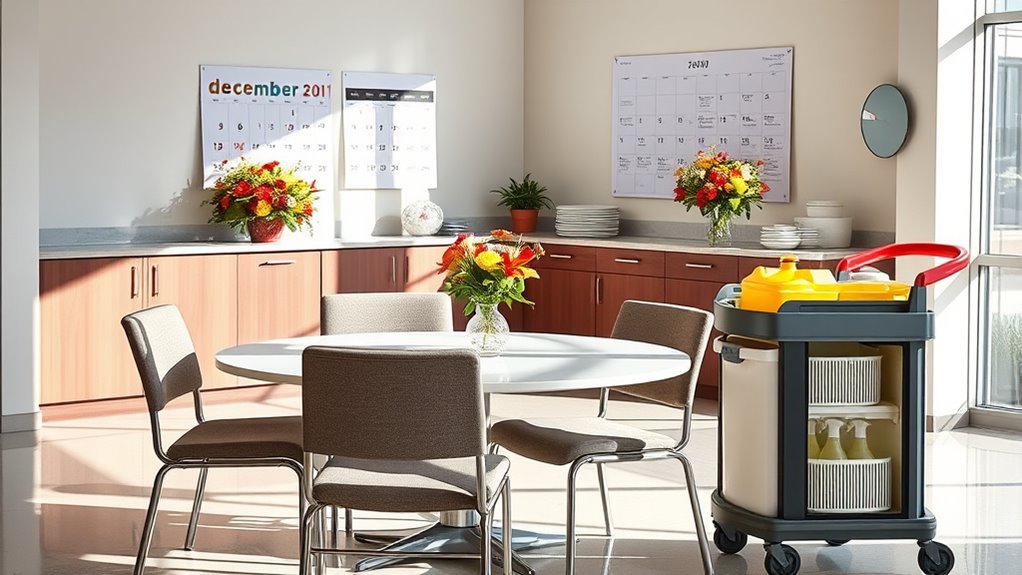
Since shared spaces are vital for team interaction, keeping them clean and organized is fundamental for everyone’s well-being.
These areas, like break rooms and conference rooms, can easily accumulate germs and clutter. Focus on high-touch areas, such as doorknobs and light switches, and make certain they’re sanitized multiple times a day, especially during cold and flu season.
Establishing a cleaning schedule for shared spaces fosters collaboration and accountability among your team.
Don’t forget to regularly empty and clean communal trash bins to eliminate odors and create a welcoming atmosphere.
Providing disinfectant wipes and hand sanitizers empowers everyone to maintain hygiene, guaranteeing that your shared spaces remain inviting throughout the year.
Review Cleaning Supplies
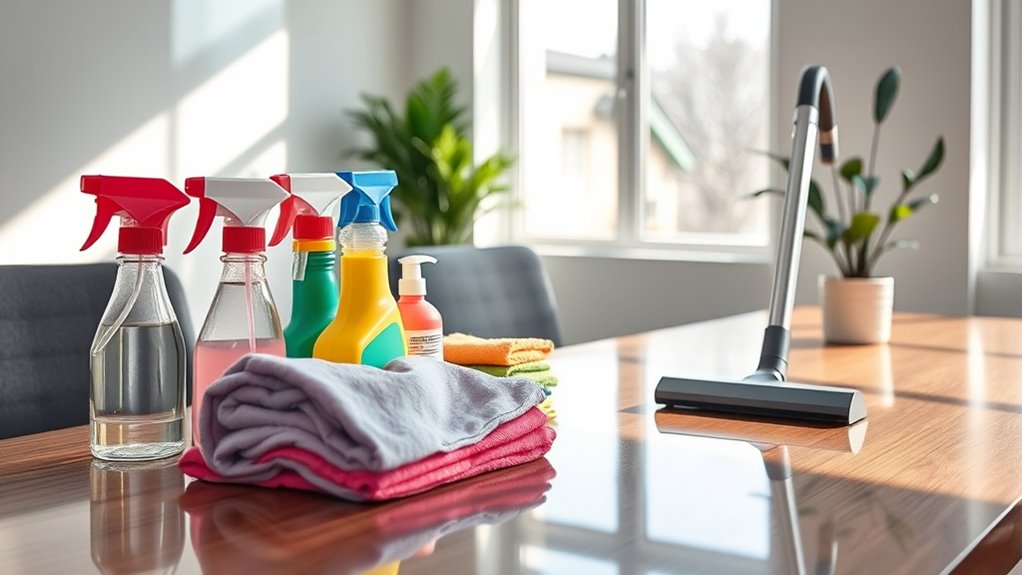
A well-stocked supply closet is essential for effective end-of-year office cleaning. Start by conducting an inventory of cleaning supplies to guarantee you have adequate stock levels of essential items.
Replace any expired or ineffective cleaning products, as fresh supplies enhance effectiveness and promote a healthier workspace. Evaluate the variety of cleaning tools available, and consider incorporating eco-friendly cleaning supplies to reduce harmful chemicals. Additionally, ensure you have disinfectants for high-touch surfaces to maintain a sanitary environment.
Creating a checklist of needed cleaning supplies for specific tasks streamlines the process.
- Disinfectants for high-touch surfaces
- Microfiber cloths for dusting
- Paper towels for spills
- Trash bags for waste disposal
Communicate With Cleaning Services
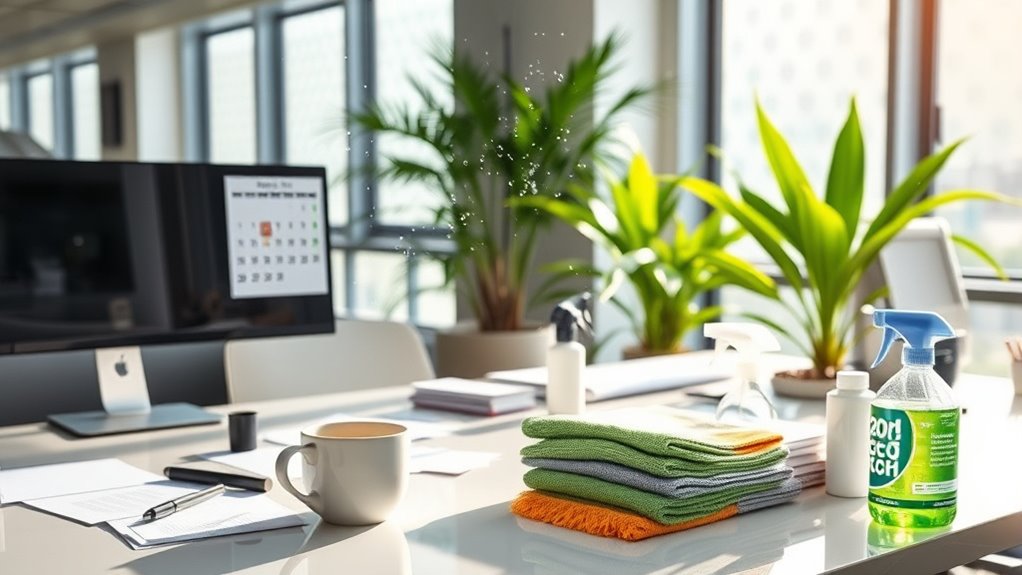
Effective communication with your cleaning service is essential for achieving a spotless office at the year’s end. Clearly outline your specific cleaning requirements, especially for high-traffic areas like conference rooms and break areas that need extra attention.
Schedule a meeting with the cleaning staff to discuss any changes or additional needs for end-of-year cleaning, ensuring everyone’s on the same page. Establish a timeline for tasks to minimize disruptions during this busy period.
Regularly provide feedback on cleanliness standards to help your commercial cleaning services adjust their approach. Maintaining open communication allows you to address immediate concerns and specific requests, ultimately creating a healthier work environment for everyone as you head into the new year.
Frequently Asked Questions
What Is the End of Year Office Clean Up?
The end-of-year office cleanup is a thorough process where you tackle cleaning and organizing your workspace.
You’ll focus on decluttering, sanitizing high-touch areas, and deep cleaning tasks like shampooing carpets and dusting surfaces.
This cleanup isn’t just about cleanliness; it’s also about boosting productivity for the upcoming year.
What Is the 20/10 Rule for Cleaning?
Ever feel like cleaning’s a mountain too steep to climb? The 20/10 Rule for cleaning can help. You work hard for 20 minutes, then take a 10-minute break.
This method keeps you focused and prevents burnout, making cleaning less intimidating. By breaking tasks into manageable chunks, you’ll find it easier to stay motivated.
Over time, you’ll create a cleaner, more organized space without feeling overwhelmed. Give it a shot; you might be surprised!
What Areas Are Most Important When Prioritizing Cleaning Tasks?
When you’re prioritizing cleaning tasks, focus on high-touch areas like door handles and light switches, since they collect most germs.
Don’t forget break rooms and kitchens; clean countertops and dispose of old food regularly.
Declutter and sanitize desks to boost your productivity.
Conference rooms need attention too, as a clean environment encourages collaboration.
Finally, keep printer stations organized to guarantee everything runs smoothly.
A clean workspace benefits everyone!
What Is the Highest Priority in a Cleaning Schedule?
The highest priority in a cleaning schedule is tackling high-touch areas first. You’ve got to focus on doorknobs, light switches, and shared equipment, since they can harbor a lot of germs.
By cleaning these spots regularly, you help protect everyone’s health in the workplace. Don’t forget daily tasks like surface wipes and garbage disposal, too.
Keeping things tidy prevents distractions and maintains a clean environment for you and your colleagues.
Conclusion
As the year wraps up, taking the time to prioritize your office cleaning can breathe new life into your workspace. By packing away holiday decorations and decluttering, you’re not just tidying up—you’re setting the stage for a fresh start. Remember, a clean environment sparks creativity and boosts morale. So roll up your sleeves, tackle those tasks, and watch your office transform into a beacon of productivity. Here’s to a cleaner, brighter year ahead!







